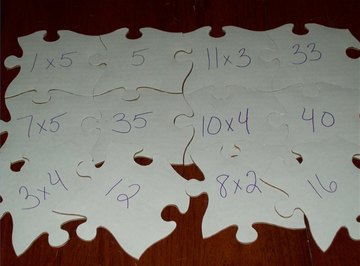When students learn how to factor a polynomial such as x2 – 8x + 15, one of the skills they need to develop is to find two numbers which can be added to get one number and multiplied to get another. A diamond problem is designed to focus on just this skill. The left and right numbers in the problem are the factors. The top number is for the product, and the bottom is for the sum.
Table of Contents
What Is Diamond Math?
Diamond problems are also referred to as “diamond math” due to the unique way that they are constructed. Most diamond problems are drawn in an actual four-sided diamond, with a large X in the middle of it that separates it into four smaller diamonds. One number is written in the diamond at the bottom, while another number is written in the diamond at the top. The diamonds on the left and right are left empty, as these are the two fields that the student has to fill in. Keep in mind that not all diamond problems are drawn in this exact way; you’ll sometimes see them with just a large X to create the four sections without the diamond shape surrounding it. Either method is fine, but the drawn diamond is the more standard version.
The rules of a diamond math problem are simple: The student has to place numbers in the two empty cells. When added together, the two numbers have to equal the number in the bottom cell. When multiplied together, they have to equal the number in the top cell. Depending on the skill level of the students, both positive and negative numbers may be required (which would result in negative numbers in the top or bottom cells, a big hint to the students.) If students are still at an early point of developing this skill, however, it’s recommended that you stick with all positive numbers to start.
How Is This Used?
Diamond math trains people to recognize possible factors that also equal a specified sum. This is very important when factoring quadratic equations using the FOIL method in algebra, since a problem such as x2 + 5x + 4 requires both multiplication and addition to come up with the factor pairs of (x + 1)(x + 4) for simplification. This skill carries on beyond just algebra as well, since algebra plays an important part in more advanced mathematics. Developing the skill now using tools such as diamond problems will make it much easier for students to identify proper factors in the future.
Solving Diamond Problems
The easiest way to solve diamond problems is to factor the top number and determine how many possibilities there are for the empty cells. Starting with the bottom number is much harder since there are a huge number of combinations of whole numbers that can be added to create a sum; if negative numbers are allowed, that number is actually infinite. Make a list of all of the combinations of numbers that create the desired product when multiplied together (such as 3 and 4 if the product is 12.) Once you have your list, try adding the two numbers together to see if they equal your desired sum (such as 3 + 4 if the sum is 7.) Once you find a match, write those two numbers in the two empty cells. It doesn’t matter which order the numbers are written in, since the numbers in the diamond problem are only in a collection and not actually in a mathematical problem. Even if they were, they are only used in addition and multiplication, which allow you to place numbers in any order and still get the same result. Cite this Article Did you find this page helpful? 👍 👎
Related Articles
How to Factor Expressions in Algebra What Are Addends in Math Addition Problems? How to Make a Math Puzzle How to Teach Multiplication to the Second Grade Using… Ideas for Math Board Games How To Play Math Bingo How to Find the X Factor in a Math Equation How to Solve Operations Puzzles How to Find the Least Common Denominator of Two Fractions How to Write the Prime Factorization in Exponent Form Math Rules for Addition Adding & Subtracting Fractions How to Teach Missing Addends How to Find Cube Root in Ti-84 How to Teach First Grade Math Subtraction Tables How to Correct a Near Singular Matrix What is the Difference Between Integers And Real Numbers? What Is an Integer in Algebra Math? How to Draw an Array in Math How to Do Sixth Grade Math Ratio Tables
References
About the Author
Photo Credits
How to Factor Expressions in Algebra

Updated November 08, 2018 By Jay Darrington
In algebra, factoring is one of the most basic methods of simplifying a quadratic equation or expression. Teachers and textbooks often emphasize its importance in basic algebra classes, and with good reason: as students delve deeper and deeper into algebra, they will eventually find themselves dealing with several quadratic expressions at the same time, and factoring helps to simplify them. Once simplified, they become much easier to solve.
How to Double-Check Your Factoring
You can double-check your newly factored expression by multiplying the factor terms together using the FOIL order. That stands for first terms, outer terms, inner terms and last terms. If you’ve done the math correctly, the result of your FOIL multiplication should be the original, unfactored expression you started with.
You can also double-check your factoring by entering the original expression in a polynomial calculator (see Resources), which will return a set of factors that you can double-check against the result of your own calculations. But keep in mind: Although this type of calculator is useful for quick spot-checks, it’s no substitute for learning how to factor algebraic expressions yourself.
Related Articles
How to Factor Pyramid Math How to Solve a Math Factor Puzzle How to Do a Diamond Problem in Math The Foil Method With Fractions How to Factor Monomials How to Find the Least Common Denominator of Two Fractions How to Factor Polynomials Step-by-Step How to Factor Polynomials & Trinomials How to Factor Higher Exponents How to Factor Polynomials With 4 Terms How to Use the AC Method for Factoring How to Factor Polynomials With Fractions How to Solve a Math Factor Puzzle How to Factor Polynomials with Coefficients How to Find All The Factors of a Number Quickly and… What Is Factoring in Math? How to Multiply Monomials How to Factor Polynomials in Factor Four Terms How to Simplify Matrix Operations How to Solve for Both X & Y
References
Resources
Tips
About the Author
What Are Addends in Math Addition Problems?

Updated October 27, 2020 By Tuesday Fuller
Addends are numbers used in an addition problem, 2 + 3 = 5. In this case, 2 and 3 are the addends, while 5 is the sum. Addition problems can have two or more addends, which can be single- or double-digit numbers. Addends can be positive, like 5, or negative, such as −6.
Significance of Addends
Educators use addends to teach basic addition to young children. Children start by learning basic addition skills for sums up to 10, and once they are comfortable with that number set, educators use addends to incorporate larger number sets from 20 to 100. Understanding addends and their functions teaches children the basics of number operations and enhances mathematical reasoning and problem solving skills.
Missing Addends
Missing addends are exactly as the name implies, meaning addends that are missing from the mathematical equation. A statement like 4 + _ = 8 contains one known addend, one unknown or missing addend and the sum. The purpose of learning addends like this is to introduce students to the basics of algebraic math. So if a student knows 5 + 6 = 11 and he sees a problem stating 5 + _ = 12, he can use his basic knowledge of addends and their sums to begin solving the problem. This is a useful skill for solving word problems. https://edc585ad9a074b82fbe2135eeb2ec012.safeframe.googlesyndication.com/safeframe/1-0-38/html/container.html
Three or More Addends
Addition problems can have more than two addends. Problems like 8 + 2 + 3 = 13 have three addends that equal 13. In addition problems that have two-digit numbers, like 22 + 82, students must carry a number into the hundreds column to solve the problem, requiring the addition of yet another addend. Problems with three or more addends teach students the important concept of grouping numbers together to solve the problem quickly. Grouping is also important because it helps students break down large problems into smaller, manageable problems that reduce the chance of mathematical errors.
Exercises With Addends
First, students learn to identify addends and their functions in addition problems. Next, teachers begin with easy addends or those considered counting numbers, 1 through 10. Students also learn double addends: 5 + 5 = 10 and 6 + 6 = 12. From there, teachers introduce the exercise called doubles plus one, a process that asks students to take a double addend, 4 + 4, and add 1 to the problem to determine the solution. Most students say 4 + 4 = 8, so if you add 1, you get 9. This also teaches grouping skills to students. Teachers also use this grouping skill to teach students about number order (i.e., 5 + 4 = 9 and 4 + 5 = 9), so students recognize that the sum does not change despite the order difference of the addends, a technique called reverse order addends.
Same Sum Addends
Another exercise to teach students about addends is called same sum addends. Teachers ask students to list all the addends that equal a particular sum. For example, the teacher asks for all the addends that equal 15. Students would respond with a list that reads 1 + 14, 2 + 13, 3 + 12, 4 + 11, 5 + 10 and so on until all the addends that equal 15 are included. This skill reinforces reverse order thinking and problem solving for missing addends.
Related Articles
How to Teach Missing Addends How to Explain Division to a Third Grader What Does Decompose Mean in Math? How to Use Counters in Math Basic Mathematics Skills Compatible Numbers for Third Grade Math How to Teach Math Facts Properties of Addition and Subtraction How to Teach Kids to Add & Subtract Associative & Commutative Properties of Multiplication How to Make a Math Puzzle How to Teach First Grade Math Subtraction Tables The Four Types of Multiplication Properties Importance of Addition in Kindergarten How to Teach your Kids to Solve Word Problems in Math Basic Concepts in Mathematics How to Teach Subtraction With TouchMath What Is Math Regrouping? How to Add & Subtract Negative Fractions How to Factor Polynomials Step-by-Step
References
Resources
How to Make a Math Puzzle

By April Fox
A math puzzle is inexpensive, finished in minutes, and lets kids get some hands-on time with numbers–important because many kids learn best when their sense of touch is engaged. Children can work on the puzzles alone or in groups and will welcome the break from the same old math sheets and quizzes. This puzzle can be created with anything from simple addition facts to algebraic equations, making it ideal for younger gifted children as well as those who are simply bored with the same old worksheets.
Conclusion
In mathematics, diamond problems are practice problems that aid in skill development. Unlike many mathematical tools that focus on building a single skill, however, diamond problems actually build two skills at the same time.
